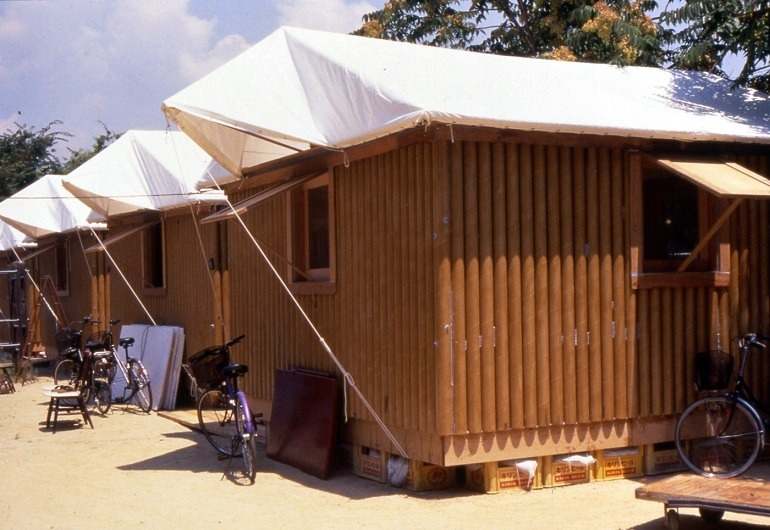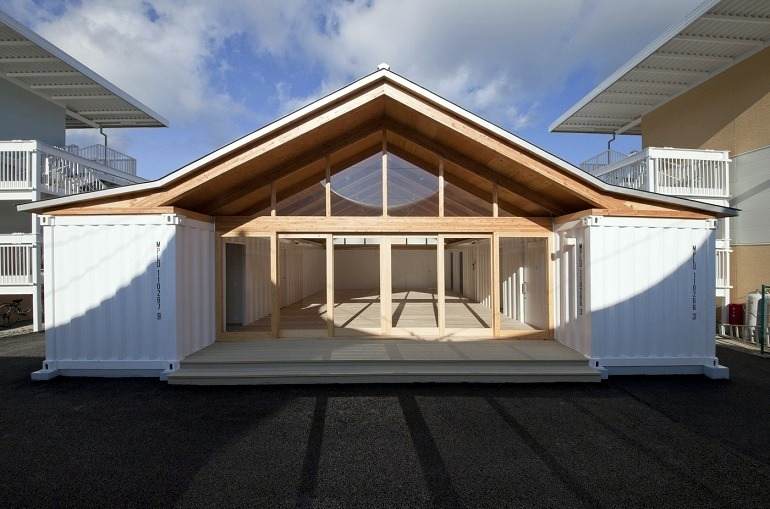ART & DESIGN
Shigeru Ban, Cardboard Cathedral 2013, is an important example of a disaster relief home. Image courtesy of Aspen Art Museum
ART REVIEW
BY KAZAD
Architect Shigeru Ban explores innovative architectural designs and humanitarian projects to provide disaster relief for victims of earthquakes, tsunamis, hurricanes, and wars around the world.

ASPEN, COLORADO — Presently at the Aspen Art Museum is an exhibition featuring the works of Shigeru Ban, one of the most innovative architects of the 21st century. Shigeru Ban: Humanitarian Architecture focuses on the creative genius of this architect, who has devoted himself to humanitarian efforts. Ban explores architectural design in a way that brings shelter, succor, and disaster relief to victims of earthquakes, tsunamis, hurricanes, and wars.
Shigeru Ban: Humanitarian Architecture allows a look into the fascinating and inspiring component of Ban’s architectural practice. It includes full-scale examples of his groundbreaking designs. Ban and Aspen Art Museum Nancy and Bob Magoon CEO and Director Heidi Zuckerman Jacobson, put the exhibition together.
The show exemplifies how creative architectural designs can benefit a large population of people who have experienced adversities.
An architect with an eye for details, Ban designed the exhibition himself. The show presents a global view of disasters and how locally and commonly available materials can help provide disaster relief for victims of disasters such as earthquakes, tsunamis, hurricanes, and war.
With his exhibition design, Ban argues that gigantic or sophisticated edifices are not necessary to assist people in need. His innovative architectural designs in different parts of the world to aid people suffering from natural and man-made disasters adequately support this point of view.
Architecture for Humanity
Looking through his architectural design oeuvre, it is clear that Ban is an unusual architect, who explores unconventional materials to great effect in his designs. Ban combines common materials to create innovative structures and designs. Such materials include paper tubes, shipping containers, bamboo, and fabric. Others are paper, and composites of recycled paper fiber and plastics. One great example of his use of unconventional materials is Paper Emergency Shelter.
Paper Emergency Shelter was a joint project with the United Nations Commission for Refugees (UNHCR), Byumba Refugee Camp Rwanda 1994-1999. During the conflict in Rwanda, many people lost their homes and began living under tragic conditions. During consultations with Ban on the best way to help the Rwandan refugees, he proposed paper-tube shelters. The result is a shelter made from reusable and recyclable materials that served the Rwanda refugees well.
The Byumba Refugee Camp in Rwanda marked Ban’s incursion into humanitarian architecture. His next project was in Japan. After the 1995 earthquake in Kobe, Japan, Ban again donated his time and talents. In Kobe, Ban used recycled materials to create shelters for Japanese who had been displaced by the devastating earthquake. His first project at Kobe was the Paper Log House. The foundation of the Paper Log House was made from beer crates filled with sandbags donated by inhabitants. For the walls of the houses, Ban lined up paper cardboard tubes vertically.
Disaster Relief from Paper Log House
Paper Log House not only ensured the safety of the people but also stabilized those that survived the terrible natural disaster, giving them hope for a better future. In addition to the shelters, Ban also helped the people fulfill their spiritual needs by designing a Paper Church, which is also part of the show at the Aspen Art Museum. Ban and his assistants built the church with paper tubes. The church was disassembled in 2008 and sent to Taiwan, where it was reconstructed.
Many of Ban’s architectural designs and projects in disaster zones are a result of collaborative efforts. Ban has engaged the people from the community, including victims, in places he has visited to create disaster relief shelters. He works with citizens, volunteers, and students, to construct simple habitable designs. These dignified, low-cost, recyclable shelters and community buildings help disaster victims.
In 1995, Ban founded the Voluntary Architects Network (VAN), a non-governmental organization (NGO). The objective of VAN is to include locals and disaster victims in disaster relief projects he builds. With VAN, Ban has conducted work in Japan, Turkey, India, Sri Lanka, China, Haiti, and Italy. He has also been to New Zealand, and the Philippines helping victims of earthquakes, tsunamis, hurricanes, and wars.
With the rate of global weather disasters, many people will need disaster assistance, and it will start with shelter. While there are several disaster relief services like the Red Cross, organizations like VAN have a major role to play.
Ban: Disaster Relief and New Ways of Helping Victims
Shigeru Ban was born in Tokyo. He is 56-year-old. In 2014, he got the Pritzker, the most prestigious award for architects. Ban got his award not just for his brilliant elegant, innovative work for private clients, both also for his inventive and resourceful design approach for his extensive humanitarian efforts.
Although Ban has created great architectural pieces for clients across the globe, what has stood him out from other architects is his innovative use of architectural design to bring relief and help to major points of disasters across the globe. For more than twenty years, Ban has been traveling to sites of natural and man-made disasters around the world to work with local citizens, volunteers, and students, to design and construct simple, dignified, low-cost, recyclable shelters and community buildings for disaster victims.
It is for his work in humanitarian activities that AAM is celebrating this great architect. Viewers were able to see not just the finished works but the process in many of the works on display at the Aspen Art Museum. In many of these architectural disasters relief shelters projects, Ban employs readily available, inexpensive, and easy-to-transport materials like recyclable cardboard paper tubes for columns, walls, and beams. These materials are easy to mount and dismantle. The materials can also be water- and fire-proofed, and recycled.
In announcing Shigeru Ban as the 2014 Pritzker award winner, Tom Pritzker said, “Shigeru Ban’s commitment to humanitarian causes through his disaster relief work is an example for all. Innovation is not limited by building type and compassion is not limited by budget. Shigeru has made our world a better place.”
ART REVIEW | READ ALSO: Whitney Museum of American Art Celebrates Jeff Koons Banality
Ban architecture designs are even more relevant now with the torrent of environmental disasters happening across the globe. From uncontrollable monster wildfires to flooding and tornados, the world has become more dangerous. All fingers point to human activities for the recent increase in weather disasters. Scientists believe that environmental pollution, deforestation, and inordinate greed are major contributors to all the environmental problems across the globe. Additionally, there is an outcry that the consequences could be devastating if humans continue in their destruction of the environment.
Disasters are Constantly Happening
Shigeru Ban: Humanitarian Architecture at the Aspen Art Museum is a reminder that disasters are constantly happening around the globe. Consequently, there should be a greater effort to help victims of earthquakes, tsunami, hurricanes, wars, and other natural disasters. Ban’s architectural designs in disaster zones have been remarkable in providing shelter and succor to disaster victims.
Paper Log House, continues to be part of the effort to help victims of disasters across the globe. Four years after it was first constructed in Kobe, Paper Log House was transformed to meet the needs of earthquake victims in Turkey. Subsequently, it moved to India in 2001 after the country was hit by a devastating earthquake. The success of Ban’s designs in helping disasters victims proves that relief assistance does not require sophisticated edifices.
Shigeru Ban: Humanitarian Architecture, on view through October 5 at the Aspen Art Museum, 637 East Hyman Avenue Aspen, Colorado 81611.

